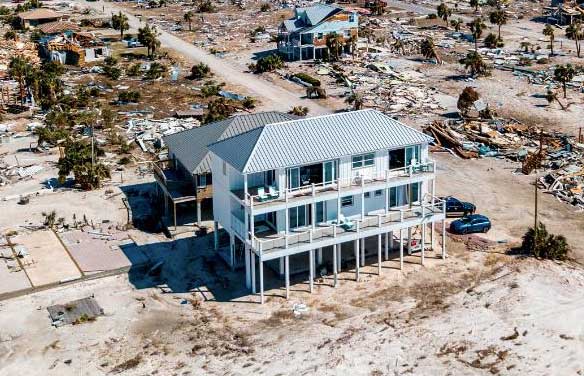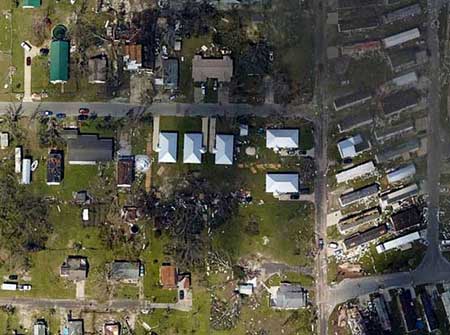Storm Protection
How to Protect Your Home from Strong Wind Damage
Across the world hurricanes, cyclones, typhones and the gale force winds are increasing in frequency and intensity. Here we discuss how you can storm proof your buildings. The recent disaster in Florida shows that many buildings are not able to withstand the strong winds, and sadly many of these houses would have survived if they had been built with a few, low cost modifications in their construction. To prove the point among the devastation 5 low cost houses remain virtually untouched by the disaster. One house built right on the seafront at Mexico Beach in Florida survived almost totally unscathed while around it was devastation, it's owners built it to withstand storms.
See also:
As we said in the previous article, cyclones (and their northern versions typhoons and hurricanes) can form a minimum of 5 degrees North or South of the equator, most are between 10 and 30 degrees North or South of the equator. Much of Indonesia is closer to the equator (around 8 degrees South) which means a direct hit is unlikely but can be subject to very strong winds and rain from cyclones that may pass quite close by. This means that full cyclone proofing is probably not necessary however precautions are advised.
Protecting your property
Let us look at what is involved in protecting houses from strong winds and particularly stormproofing techniques that are used in Northern Australia where cyclones are common.
Most houses in Australia and America these days are built with a timber or lightweight steel frames lined on the inside with plasterboard (gyprock, gypsum or drywall) and on the outside with a veneer of brick (for ornamental rather than structural purposes). They have timber or light steel roof trusses which support heavy concrete roof tiles or zincalume sheets.
A continuous system of firmly connected components
In Australia it is well recognised that stormproofing requires a continuous system, the roof tiles are fixed to the battens (usually nailed or better screwed), the battens are fastened to the roof trusses (nailed and strengthened with sheet steel straps), the roof trusses are fixed to the wall frames (also nailed or screwed and strengthened with straps) and the wall frames are bolted to the foundation slab.
In America most roofs are made from asphalt shingles which are glued and/or stapled onto plywood. These lightweight roofs need special care particularly around the edges, once an edge lifts the wind has something to work on and the whole roof can easily lift off.
In many countries construction is quite different and most houses are built with a reinforced concrete box structure of columns and beams with the walls filled in with batu merah (red brick) or batako (lightweight concrete blocks). Roofs usually have wooden frames or more often these days lightweight steel frames which tend to sit on the concrete structure with minimal fixing. Tiles are usually terracotta which are not fastened down, alang alang is common which is tied to a bamboo or wooden frame and to a lesser extent sheet steel, asbestos and Onduline which are nailed, or better, screwed down.
To stormproof (and for that matter earthquake proof) a house here it is important to make sure that the reinforcing steel inside the structure is locked together where the columns meet the beams and where the structure meets the floor. It is also important, though usually omitted, to use steel ties to fasten the batako or red brick wall panels into the concrete columns. This latter point may sound unnecessary however I am aware of a batako (lightweight concrete block) wall that blew down during recent strong winds. Fortunately no one was hurt but it could have been fatal if someone had been in the wrong place at the wrong time.
Roofs
What is most important is that the roof is firmly fixed to the concrete structure.
Roofs are the parts of any building that are most vulnerable to strong winds and there are several aspects to consider. The first is the angle of the roof to the wind. Steeply sloping roofs present an obstruction that can, like a wall, be damaged by pressure.
The aerofoil effect
Of greater concern, however, is when a roof is not sloping enough and the whole roof acts like the aerofoil of an aircraft wing. Wind passing over the roof speeds up as it goes over the ridge creating suction which can lift the roof off. Forces involved should not be underestimated, think of how little wing area is needed to lift a large aircraft off the ground (usually at around 160 knots) and you can see how much power can be generated by the aerofoil effect.
A good slope for a roof is probably around 30 degrees.
Roof tiles can be lifted if strong winds can penetrate and close fitting tiles should be preferred over tiles that can allow air to get under them. Close fitting tiles also are better for reducing water penetration.
Roofs covering should be firmly secured
Roof coverings of tiles or corrugated iron need to be firmly secured to withstand strong winds, In cyclone latitudes it is imperative that each tile and roof sheet is individually secured preferably with screws rather than nails.
Wind traps in roofs
Gabled roofs (roofs where the roof ridge continues to the end of the roof as opposed to hip roofs which have an angled section of roof across the end) are susceptible to damage because the gables trap the wind. Gabled roofs need to have their vertical wall well braced to withstand strong winds.
The wind can also get under the eaves around the edge of a roof and, once again, lift it off. Eaves are important because they stop wind getting into your roofspace. Eaves are often forgotten being made from something relatively flimsy (such as plasterboard) and without much bracing. If they fail large amounts of water carried by strong winds can penetrate the roof space and do serious damage easily bringing down a ceiling made from plasterboard.
Protect doors and windows
Windows and doors may fail during a heavy storm, glass may break or doors may open particularly if they are hit by flying debris. Once they fail high pressure may develop inside the building which can under severe conditions blow the building apart. Hinges, locks and catches should be strong enough to withstand a storm but also be aware that door or window frames can be pulled out of walls so the frame fixtures also need to be strong.
Taping the glass in your window panes might not stop them breaking in a violent storm but will help to hold the glass and stop it blowing around if it breaks. Masking tape is good, fabric based tape such as gaffer tape or the American version of duct tape is best.
To prepare for serious cyclones it is common practice to cover doors and windows with pieces of thick plywood. As is often the case our ancestors had tricks we can learn from and houses in tropical storm areas often had shutters on their windows which provide good storm protection.
Storm surge and flying debris
Statistics indicate that in a cyclone most fatalities are caused by storm surge, the rising of sea level due to strong winds. It makes sense to build on higher ground or evacuate at times of an incoming storm.
After storm surge flying debris is probably the most dangerous aspect of any storm. In Australia, with widespread use of sheet steel for roofs, flying pieces of zincalume (corrugated iron) pose a particularly frightening prospect.
Beware of rust in bolts nails brackets and fixtures
Building structures and components can be weakened by damage from rust, rot, termites or by fittings such as bolts or nails coming loose which in turn can allow things to fall apart under stress. Regular inspection should be carried out to keep on top of these issues.
Satellite dishes, roof materials, pergolas, air conditioners, water heaters, solar panels and antennas may break loose and turn into missiles. They all need to be firmly secured. Also look out for outdoor furniture, awnings, umbrellas and swimming pool equipment which should all be put away before strong winds arrive.
Trees and broken branches
Branches may be blown off trees. Be particularly aware of regrowth. Original branches that form on a tree as it grows are far more firmly attached to the rest of the tree than branches that regrow after a tree has been pruned. Dead branches should be removed.
Trees may also fall over especially if the roots are rotten or if the ground becomes waterlogged around the base of the tree.
Be careful of trees in any storms.
Driving rain
Strong winds are not the only risk from cyclones, in heavy rain the strong winds can drive water through any openings in walls, windows under doors etc. Once water enters it can cause a lot of damage. Go around your walls and check that holes are sealed up and don't forget the inevitable gaps around air conditioner piping or where air conditioners have been removed.
Cyclones, like elections, should not be underestimated, they can be very dangerous things. A friend of mine who survived being in a house that suffered a direct hit during Darwin's cyclone Tracy back in 1974 told a harrowing story. Only one partial wall survived, the one the bed he was hiding under was leaning against. The last thing his host said as he went off to a Christmas party was “look after the house.”
See also:
Phil Wilson
Copyright © Phil Wilson February 2012
This article, or any part of it, cannot be copied or reproduced without permission from the copyright owner.

 Storm proofed house on Mexico Beach Florida - see full CNN image here
Storm proofed house on Mexico Beach Florida - see full CNN image here Storm proofed houses that survived Hurricane Michael - read the Washington Post article here
Storm proofed houses that survived Hurricane Michael - read the Washington Post article here